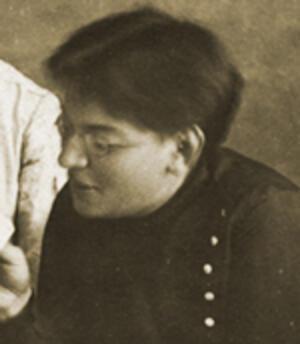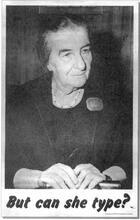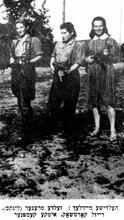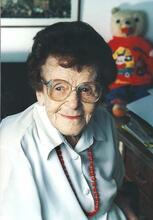Mania Wilbushewitch Shochat
Mania Wilbushewitch was born in 1880 in the area of Lososna near Grodno in Western Russia. She devoted her life first to labor activism in Russia, then to Jewish socio-economic and self-defense causes in Palestine. Wilbushewitch’s political activism in Minsk led her to create a legal trade union and then to join a terrorist group. After spending a year traveling throughout Palestine, she decided that a large class of Jewish workers and Jewish self-sufficiency was critical to the development of Erez Israel. Wilbushewitch and her husband established the Jewish defense group Ha-Shomer in 1909. She was one of the founders of the League for Jewish-Arab Friendship and spent the rest of her life focusing on social work in Palestine and peace between Jews and Arabs.
Early Life and Family
Mania Wilbushewitch was born in 1880 on an estate in the area of Lososna near Grodno in Western Russia. She ran away from home at the age of fifteen to become an industrial worker in the carpentry workshop of her brother Gedaliah (1865–1943) in Minsk. Here she first became acquainted with fellow Jews, since her upbringing in Lososna had exposed her primarily to the lives of peasants. In Minsk she learned Yiddish and interacted with Jewish laborers. Before long she found herself coordinating a massive strike of the workers against her brother, in protest at the extremely long work day he had imposed upon them. This episode marked the beginning of what was to become her decades-long devotion to ameliorating the working conditions of industrial and agricultural laborers.
Mania’s mother was a secularist who waged battle against her husband’s desire to educate his sons as rabbis; her wealthy, fervently religious father, Ze’ev, employed many Russian peasants at his grain mill on the banks of the Neiman River. Mania’s uncle (her mother’s brother) was the female/sing.: Member of the Haskalah movement.maskil Samuel Joseph Fuenn (1818–1890), editor of the Jewish Enlightenment; European movement during the 1770sHaskalah periodical Ha-Karmel. She was thus influenced in her upbringing by multiple ideological and religious approaches to culture and society. Mania was the eighth of ten children in the family; her siblings translated variegated, strongly ideological positions into actions ranging from Lit. "ascent." A "calling up" to the Torah during its reading in the synagogue.aliyah—Isaac, Gedaliah, Moshe (1869–1952) and Nahum (1879–1971)—to joining the terrorist Social Revolutionaries. Some of them, including her oldest sister, committed suicide upon becoming disillusioned with the viability of their ideals. Mania Wilbushewitch herself was steadfastly religious in her childhood but later adopted a broad range of ideologies from family and acquaintances. Over time she developed her own approach toward the Jewish condition as well as the condition of Russian peasants as she witnessed the increased physical and, more particularly, economic suffering of both.
Russian Labor Activism
While in Minsk, she encountered members of various revolutionary groups—Jewish and Russian, moderate and extreme. She absorbed components of each approach and, typically for her, translated her various theories into practice: she established secret study groups for the purpose of teaching workers literacy, history, economics, and socialism. She later joined the effort in the Tartar region to bring economic and medical relief to peasants suffering from drought and disease. It was here that she first witnessed the mir—the Russian communal system, which impressed her as socially and economically just. Upon returning to Minsk, she established an urban collective there as well.
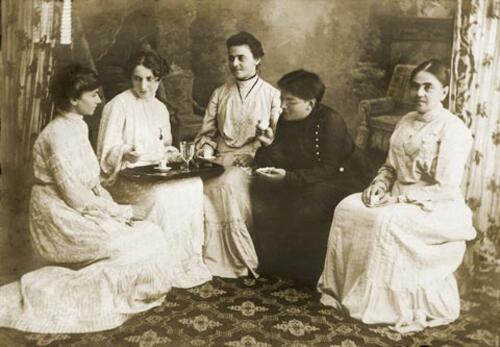
Olga Belkind, midwife and Zionist, meets with a group of women including Mania Shochat, a political activist and Zionist. (L to R): 1. Shoshana Feinberg, married Nahum Wilbush (Wilbushewitch, 1879–1971) 2. Doba Belkind, married Israel Belkind (1861–1929) 3. Alexandra (Sonia) Belkind (1858–1943), physician, married Menahem Hankin (1868–1937) 4. Mania Wilbushewitch Shochat (1880–1961), married Israel Shochat (1886–1961) 5. Olga Belkind (1852–1943), married Yehoshua Hankin.
Courtesy of Tamar Eshel
Mania Wilbushewitch’s political activism in Minsk landed her in prison, where she formed an unexpected partnership with Sergei Zubatov, head of the Moscow secret police. With Zubatov’s encouragement, she established a legal trade union, the Jewish Independent Labor Party, in June 1901. The objective of this party was to improve working conditions (i.e. by earning higher wages and working fewer hours, by improving hygienic conditions). With Zubatov’s guarantee that the government would not interfere, the party would shield Jews from harassment as long as they engaged only in labor issues and did not employ revolutionary means toward their ends. The party was quite successful at first and in late 1901, having been granted the legitimacy of government permission for its establishment, its members elected Mania Wilbushewitch to serve on its central committee. As an envoy of the central committee to St. Petersburg, she met the famed Father Gapon, a Christian reformer and priest whose sympathies for the proletariat fostered her own socialist inclinations.
Before long, however, the Russian Minister of Interior Vyacheslav von Plehve became disillusioned with Zubatov and with the new movement he had encouraged Mania to form. Von Plehve exiled Zubatov and rallied the Russian masses against the Jews—a move that ultimately led to the 1903 Kishinev pogrom. It was at this point that she began to consider violence as an effective measure and joined a terrorist cell.
Travel in Palestine
Wilbushewitch went to Berlin in order to raise funds for her terrorist group, but her brother Nahum feared the risks involved in this sort of activism and in January 1904 tricked her into joining him in Palestine. Thus she was first exposed to Palestine and soon thereafter learned that her terrorist cell in Russia had been infiltrated and its members executed. Believing that her political efforts would henceforth be futile in Russia, she now focused her attention on labor issues in Palestine. She spent a year traveling throughout the country, observing the conditions of Jewish settlement there. This year of travel influenced her greatly and she began to apply her theories on labor to practical matters of settling The Land of IsraelErez Israel. During this year Wilbushewitch concluded that a large class of Jewish workers was critical to the development of Erez Israel into a Jewish state and that Jewish self-sufficient collective agricultural settlement was, in turn, essential to the development of such a Jewish working class.
The first leg of Mania’s travels was with her brother Nahum, an engineer who had been appointed to survey Palestine’s geography and natural resources. The results of his survey were expected to help in planning capital investment in the land, cultivating conditions beneficial for Jewish immigration and laying the groundwork for the development of industry in Palestine. Nahum invited Mania to join him on his six-week study tour; she accepted and on the trip underwent a thorough conversion to Zionism—a conversion that in fact had its roots in the ideals her parents and siblings had instilled in her while young.
Immigration and Zionist Efforts
Mania Wilbushewitch’s arrival in Palestine in 1904 coincided with the Second Aliyah, comprising mostly radical young Russians. As she continued with her own study of the twenty-three Jewish rural settlements in Palestine, she further developed her suggestions for improved work and settlement conditions both for members of the First Aliyah, who depended largely on Arab laborers for help both at home and on the farms, and for members of the Second Aliyah, who were largely unemployed, lacking in family support and inexperienced in farming. Her strong emphasis on Jewish self-support and self-reliance as solutions to these problems was initially rejected by the Jewish Settlement Association as well as by her cohort of socialist Zionists. But by 1907 Mania had succeeded in merging the two groups and thenceforth played an active role in Jewish labor and settlement in Palestine.
As a Zionist as well as a socialist, Mania Wilbushewitch took on numerous leadership functions in Palestine. She spent years studying various models of agricultural collectives. In Paris, for example, she researched relevant material on the French colonies of Algeria and Tunis. In early 1907 Mania traveled to the United States for six months, continuing her study of collectives and briefly residing in a commune in New York. While she no longer lived in Russia or participated in its politics, she persisted in her fund-raising efforts for Jewish self-defense there. She also worked tirelessly at promoting peace between Arabs and Jews in Palestine.
Jewish Self-Defense
In addition to these various leadership roles, Mania Wilbushewitch became very involved in Jewish self-defense in Palestine. Late in 1907, at the nexus of self-defense and agricultural collectives, Mania finally wove together the many Zionist and socialist threads she had been considering. On September 29, 1907, the two pioneers, Po’alei Zion members Izhak Ben-Zvi (1884–1963) and Israel Shochat (1886–1961), gathered together their cohort in Jaffa and established a secret Jewish self-defense organization, Bar-Giora. Mania, in the meantime, had finally obtained permission to try implementing her ideas of collective agricultural settlement in Sejera, a farm community in the Lower Galilee whose purpose was to guide Jewish farmers toward self-sufficiency. Requiring volunteers to help her implement the experiment, and having already established connections with members of Po’alei Zion through her involvement in Jewish workers’ issues, she now contacted Israel Shochat who recognized that he could utilize her proposed settlement for the purpose of training Jewish self-defense guards.
Thus the collective at Sejera was established, with Mania Wilbushewitch and Israel Shochat as its primary leaders. The two, who had become lovers at Sejera, married in May 1908. During the first year of the collective Israel persuaded Mania that Jewish guards, in place of Arabs, were essential to Jewish existence in Palestine; thus together they established the Jewish defense group Ha-Shomer in 1909. Though the collective settlement under the leadership of Mania and Israel at Sejera lasted only one year, Mania Shochat considered it a success as a socio-economic experiment, a proof that women were as competent as men at agricultural work, and a means of fostering Jewish self-defense.
Turkey entered World War I in October 1914 with great animosity toward Jewish settlements in Palestine. Government agents infiltrated Jewish homes and organizations, searching for food, valuables and weapons. Together with other members of Ha-Shomer, Mania Shochat went underground, hiding her arsenal of weapons. However, she was found and arrested and, together with Israel, was banished to Anatolia until the spring of 1919, when both joined the Ahdut Avodah party in Palestine. During the first four years of her marriage she gave birth to a son, Geda, while her daughter Anna was born in Anatolia in 1916.
In 1921 Mania Shochat was sent to the United States as a member of a Histadrut (Palestine labor movement) delegation in order to encourage American investment in the Histadrut’s new Workers’ Bank (Bank Hapoalim). Surreptitiously, however, she was also hoping to raise large amounts of money toward the purchase of weapons for the Haganah, the paramilitary organization of the Histadrut. To this end she turned to Henrietta Szold, American Zionist and founder of the Hadassah organization, for a letter of introduction to prominent American Jewish leaders. Szold expressed her sympathy for the cause of Jewish self-defense but ultimately refused to support Mania Shochat’s clandestine activities. Nevertheless, Mania forged ahead and successfully approached the leaders on her own, receiving an especially warm welcome from Zionist and communal rabbi Judah Magnes, whom she had met at the Seventh Zionist Congress in Basel in July 1905 and who now helped her network with Jewish immigrant leaders in the United States.
The support of these American Jewish leaders for Mania Shochat’s projects diminished, however, when the Bundist leader Vladimir Medem publicly attacked her and the rest of the Histadrut delegation in the American Yiddish newspaper Der Forverts (Daily Forward). In December 1921 Medem accused Shochat of collaborating with the tsarist authorities and acting as their agent. Furthermore, he stressed that American Jewish funds and the American Jewish labor movement had no business supporting Zionists and Jewish workers in Palestine. Those in Palestine, Medem said, represented a truly insignificant percentage of all Jewish workers; instead, he believed, American Jews should support European Jewry. A public debate on these and related political issues ensued in Der Forverts and in the Poalei Zion newspaper Die Zeit.
Mania Shochat succeeded in raising several thousand dollars from private funders in the United States. She forwarded this money to her husband Israel in Vienna, where he then oversaw the procurement and shipment of weapons for the Haganah in Palestine. By the time Mania Shochat left the United States in 1922, she had failed in her goal of raising more significant funds for the Haganah; nor was the Histadrut delegation’s objective of promoting investment in Bank Hapoalim completely successful. However, she did manage to establish close ties with leaders in the American Jewish community. She also created a network of connections and relationships between the Jewish workers’ movement in Palestine and in the United States, and between the Histadrut and American Zionist leaders.
Later Life and Personal Life
Mania Shochat continued to devote the rest of her life to Jewish socio-economic and self-defense causes, social work in Palestine, and the hope for peace between Jews and Arabs. She was one of the founders of the League for Jewish-Arab Friendship, established in 1930. In 1948, she joined the pioneering left-wing Labor Zionist Mapam party in Israel.
Mania Shochat’s private life was far from blissful. Israel Shochat had extra-marital affairs, to Mania’s great misery; apparently at least in part due to this personal devastation, she attempted suicide at least once. Nonetheless, she remained married and devoted to him. Their children, Anna and Geda, were brought up steeped in the lifestyle and ideologies that dominated their parents’ lives. In an interview with the Israeli newspaper Haaretz in 1986, when she was seventy years old, Anna bitterly described a childhood in which she was effectively an orphan, while her parents devoted their entire lives to their causes. Geda, who became a pilot, later committed suicide.
Mania eventually settled down in Tel-Aviv, where she died in 1961 in her apartment; her husband died that same year. She was buried in the Ha-Shomer section of the cemetery at A voluntary collective community, mainly agricultural, in which there is no private wealth and which is responsible for all the needs of its members and their families.kibbutz Kefar Giladi, in Israel.
Ben-Zvi, Rachel Yanait. Before Golda: Manya Shochat: A Biography. Trans. Sandra Shurin. New York: 1989.
Ben-Zvi, Izhak. Sefer ha-Shomer: Divre Haverim (Hebrew). Tel-Aviv: 1962.
Raider, Mark A. “Emissaries in the Promised Land: Manya Shochat, Chaim Arlosoroff, and Enzo Sereni in the USA.” In Judaism 49:1 (Winter 2000): 59–79.
Goldstein, Yaacov. “Heroine or Traitor? The Controversy over Manya Vilbushevich-Shohat and Her Links with Zubatov.” Studies in Contemporary Jewry 6 (1990): 284–305.
Reinharz, Shulamit. “Toward a Model of Female Political Action: The Case of Mania Shohat, Founder of the First Kibbutz.” In Women’s Studies International Forum 7:4 (1984): 275–287.
Idem. “Manya Wilbushewitz-Shohat and the Winding Road to Sejera.” In Pioneers and Homemakers: Jewish Women in Pre-State Israel, edited by Deborah S. Bernstein. Albany, NY: 1992.
Reinharz, Jehuda, Shulamit Reinharz and Motty Golani, eds. The Fearless Visionary in the Land of Israel: The Letters of Manya Shohat, 1906–1960 (Hebrew). Jerusalem: 2005.

